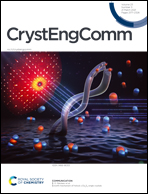Sensitive RHEED signature of Ti-excess enabling enhanced cationic composition control during the molecular beam epitaxy of SrTiO3 based solid solutions†
Abstract
Molecular beam epitaxy (MBE) is the best suited technique to engineer perovskite oxide properties, thanks to individual atom evaporation from elemental sources. Unfortunately, significant source drift often prevents exploiting this advantage, and improving the control of the composition of MBE grown oxide thin layers remains a challenge. In this context, in situ reflection high energy electron diffraction (RHEED) has long been identified as a useful tool, as surface reconstructions and RHEED oscillations depend on oxide cationic composition. We show here that monitoring the appearance of half-order streaks along the [210] RHEED azimuths of Ti-rich surfaces provides enhanced control of the cationic composition of SrTiO3 thin layers as compared to the more common strategy relying on [100] azimuths monitoring. We also provide quantitative evaluation of the uncertainty on composition control enabled by this method, namely ±6.7%. In the end, we describe an original procedure to control the composition of perovskite oxide quaternary solid solutions.

- This article is part of the themed collection: Crystal Growth


 Please wait while we load your content...
Please wait while we load your content...